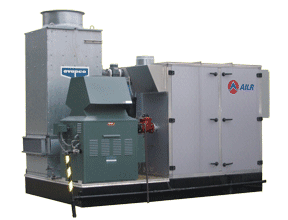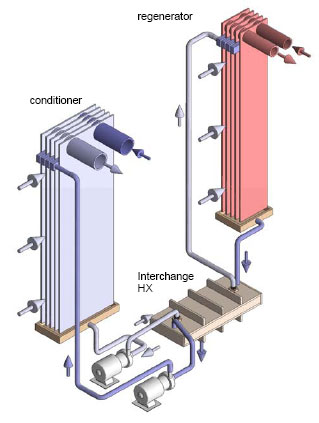![]()
![]()
![]()
![]() Integrated CHP Modules
Integrated CHP Modules
![]() Steam Turbine Chillers
Steam Turbine Chillers
![]() Adv. Liquid Desiccants
Adv. Liquid Desiccants
![]()
![]()
![]()
Integrated CHP Systems Corp. 50 Washington RdPrinceton Junction, NJ 08550 Phone: (609) 799-2340 |
||||
 |
|
Integrated CHP Systems Corp. and AIL Research Join Forces to Revolutionize Air Conditioning, Improve Indoor Air Quality and Lower Rising Electric Bills Integrated CHP Systems Corp. will use its considerable business development, application engineering and marketing expertise to assist AIL Research in commercializing its new liquid desiccant technology developed in conjunction with DOE's National Renewable Engineering Laboratory. New Liquid Desiccant Technology The 20th century was a period during which the cooling and dehumidification of homes and commercial buildings switched from being a luxury to a necessity. In the U.S. alone, air conditioning is a $10 billion industry that uses almost 5% of the nation's energy consumption. Perhaps equally as important as its energy use, air conditioning is often the single largest contributor to our overloaded electric transmission and distribution systems. We are just beginning to realize that our approach to air conditioning must change to achieve a globally sustainable energy solution.
Current system designs often create indoor environments that are uncomfortable and unhealthy because humidity is high. The fundamental problem is that a cold heat exchanger, whether it is a chilled-water coil or a DX evaporator, is a poor way to dehumidify air. A 45 F heat exchanger will typically provide 70% of its total cooling as sensible cooling (i.e., temperature reduction) and 30% as latent cooling (i.e., dehumidification). In many applications, this latent/sensible split must be reversed if indoor humidity is to be adequately controlled. Desiccants—which are materials that have a high affinity for water vapor—can be part of a sustainable approach to maintaining healthy and comfortable indoor environments. Desiccants are unique in that they can dry air without first cooling the air below its dewpoint. Latent cooling can be more than twice sensible cooling. Once the desiccant is loaded with water, heat is used to return the desiccant to its “dry” state. High electrical demand of the compressor in a conventional conditioner is replaced by the need for thermal energy to regenerate the desiccant. This creates an important opportunity to use solar thermal energy for air conditioning. Learn more about this exciting new product:
|
||||
home | services | products | market research | about us | contact us |

